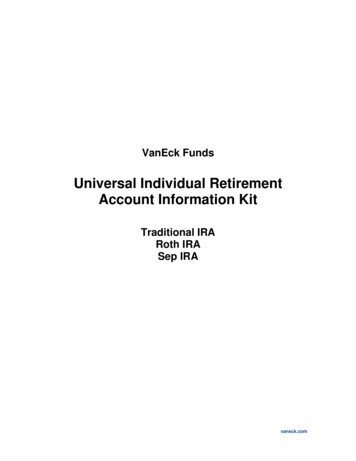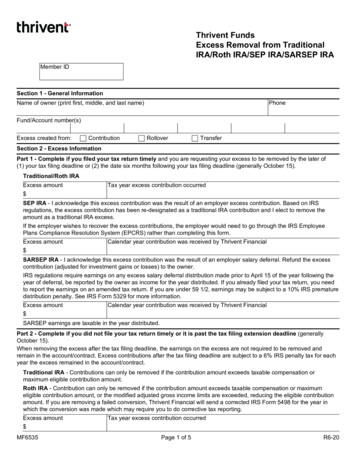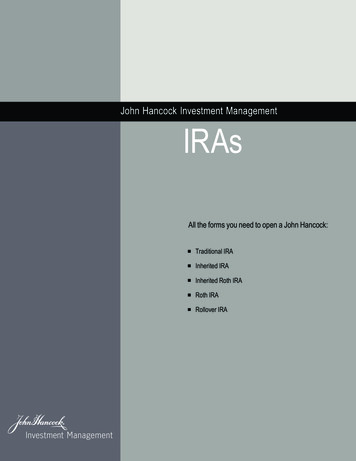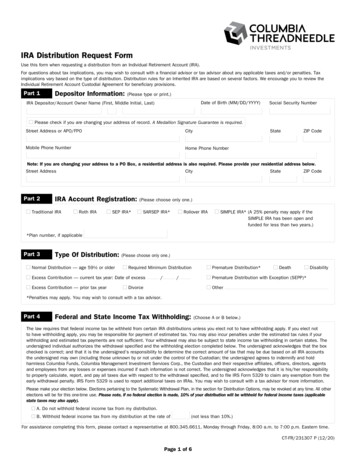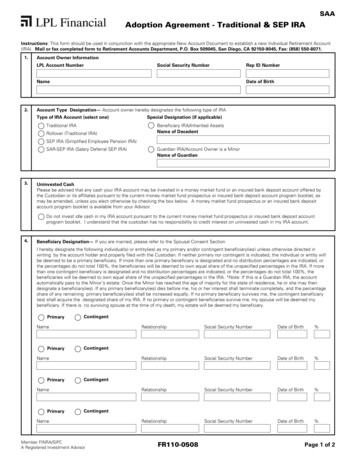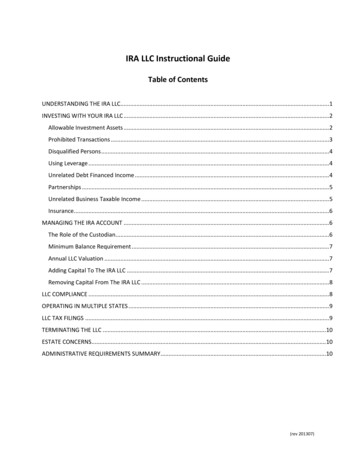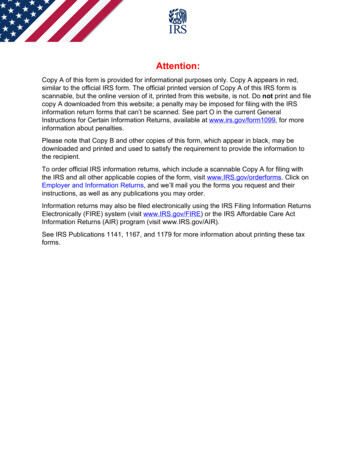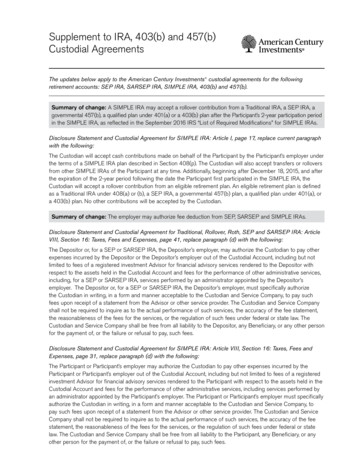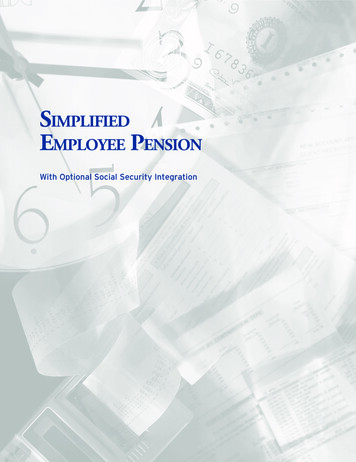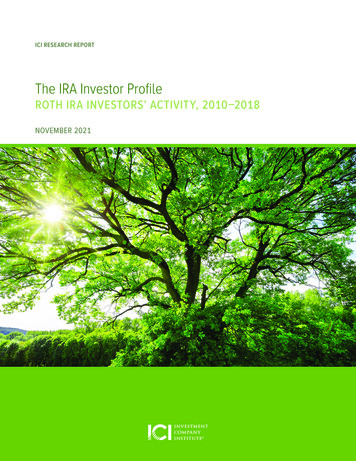
Transcription
ICI RESEARCH REPORTThe IRA Investor ProfileROTH IRA INVESTORS’ ACTIVITY, 2010–2018NOVEMBER 2021
The IRA Investor Database The Investment Company Institute maintains an account-level database on millions of individualretirement account (IRA) investors. The aim of this database is to increase public understanding of thisimportant segment of the US retirement market by expanding on the existing household surveys andInternal Revenue Service (IRS) tax data on IRA investors. By tapping account-level records, researchdrawn from the database can provide important insights into IRA investor demographics, activities,and asset allocation decisions. The database is designed to shed light on key determinants of IRAcontribution, conversion, rollover, and withdrawal activity, and the types of assets that investors hold inthese accounts.The Investment Company Institute (ICI) is the leading association representing regulated funds globally,including mutual funds, exchange-traded funds (ETFs), closed-end funds, and unit investment trusts (UITs) in theUnited States, and similar funds offered to investors in jurisdictions worldwide. ICI seeks to encourage adherenceto high ethical standards, promote public understanding, and otherwise advance the interests of funds, theirshareholders, directors, and advisers.Suggested citation: Holden, Sarah, and Daniel Schrass. 2021. “The IRA Investor Profile: Roth IRA Investors’ Activity,2010–2018.” ICI Research Report (November). Available at www.ici.org/files/2021/21 rpt ira roth.pdf.Copyright 2021 by the Investment Company Institute. All rights reserved.
The IRA Investor Profile: Roth IRA Investors’Activity, 2010–2018Contents111Executive Summary2Roth IRA Investors’ Activities, 2010–20183Snapshot of Roth IRA Investors at Year-End 2018 Provides Additional Insight into Roth IRAInvestors’ ActivitiesNew Roth IRAs Often Are Created by Contributions3More Than Three in 10 Roth IRA Investors Make Contributions to Their Roth IRAs3Roth IRA Conversion Activity Responds to Rule Changes4Few Roth IRA Investors Have Rollovers4Few Roth IRA Investors Take Withdrawals4Roth IRA Balances Tend to Increase with Investor Age4Equity Holdings Figure Prominently in Roth IRAs5Roth IRA Investors Are Quite Different from Traditional IRA InvestorsIntroduction11The Role of IRAs in US Retirement Planning12Sources of IRA Data12The IRA Investor Database 13153Research Agenda for This ReportCHAPTER 1: Following Roth IRA Investors over Time15Financial and Regulatory Developments18Changes in Roth IRA Assets18Changes in Consistent Individual Investors’ Roth IRA Balances, 2010–20183020Contribution Activity for Consistent Roth IRA Investors, 2011–201823Conversion Activity for Consistent Roth IRA Investors, 2011–201824Withdrawal Activity for Consistent Roth IRA Investors, 2011–201825Equity Investing in Roth IRAsChanges in Consistent Individual Investors’ Roth IRA Balances Between 2010 and 2018 byInvestor Age
33CHAPTER 2: Roth IRA Investors’ Contribution Activity in 201833Contributions Often Were the Source of New Roth IRAs in 201834Contributions to Roth IRAs36Contributions to Roth IRAs in 2018 by Investor Age4137Roth IRA Contribution Amounts in 2018 by Investor Age39Roth IRA Investors’ Contribution Amounts Varied in 201840Older Roth IRA Contributors Were More Likely to Contribute at the Limit in 2018Persistence in Contribution Activity Among Roth IRA Investors from 2017 to 201842434955CHAPTER 3: Roth IRA Investors’ Conversion and Rollover Activity in 201843Roth IRA Conversion Activity44Roth IRA Conversion Activity in 2018 by Investor Age46Roth IRA Conversion Amounts in 2018 by Investor Age47Roth IRA Rollover Activity Is Rare48Conversions and Rollovers Tend to Have a Positive Impact on Roth IRA BalancesCHAPTER 4: Roth IRA Investors’ Withdrawal Activity in 201849Roth IRA Withdrawal Activity50Roth IRA Withdrawal Activity in 2018 by Investor Age52Roth IRA Withdrawal Amounts in 2018 by Investor Age53Roth IRA Withdrawal Activity in 2018 by Age and Account BalanceCHAPTER 5: Roth IRA Investors’ Balances at Year-End 201855Roth IRA Balances in 2018 by Investor Age565967Contributions at the Limit Tend to PersistDistribution of Roth IRA Balances by Size in 2018CHAPTER 6: Snapshots of Investments in Roth IRAs at Year‑End 2010 and Year-End 201859Investments in Roth IRAs in 2018 by Investor Age63Snapshots of Allocation to Equity Holdings Between 2010 and 2018Appendix67Role of IRAs in US Household Balance Sheets68The IRA Investor Database Contains a Comprehensive Cross Section of IRA Investors70Contributions Often Were the Source of New Roth IRAs in 201872Exposure to Equity Holdings Among Roth IRA Investors by Account Size77Notes83References
FiguresThe following, unless otherwise specified, apply to all data in this report: components may not add to the totalspresented because of rounding.Executive Summary5FIGURE E.1Roth IRA Investors Are Younger Than Traditional IRA Investors6FIGURE E.2New Roth IRAs Often Are Opened with Contributions; New Traditional IRAsOften Are Opened with Rollovers7FIGURE E.3Roth IRA Investors Rarely Take Withdrawals; Traditional IRA Investors AreHeavily Affected by RMDs8FIGURE E.4Roth IRA Assets Have a Higher Allocation to Equities9FIGURE E.5Roth IRA Investors Have Higher Concentration in Equity HoldingsCHAPTER 1: Following Roth IRA Investors over Time16FIGURE 1.1Financial Events and Changing Rules Surrounding Roth IRAs17FIGURE 1.2Roth IRA Assets and Flows19FIGURE 1.3Domestic Stock and Bond Market Total Return Indexes21FIGURE 1.4Factors Influencing Changes in Consistent Individual Investors’ Roth IRABalances22FIGURE 1.5Contribution Activity for Consistent Roth IRA Investors25FIGURE 1.6Withdrawal Activity for Consistent Roth IRA Investors26FIGURE 1.7Equity Holdings Account for Majority of Assets in Roth IRAs28FIGURE 1.8Changes in Concentration of Consistent Roth IRA Investors’ Equity Holdings29FIGURE 1.9Changes in Zero Allocation to Equity Holdings Among Consistent Roth IRAInvestors30FIGURE 1.10Changes in 100 Percent Allocation to Equity Holdings Among ConsistentRoth IRA Investors31FIGURE 1.11Roth IRA Balances Among Consistent Roth IRA Investors32FIGURE 1.12Roth IRA Balances Among Consistent Roth IRA Investors by Investor Age
CHAPTER 2: Roth IRA Investors’ Contribution Activity in 201834FIGURE 2.1Paths to Roth IRA Ownership35FIGURE 2.2Roth IRA Contribution Rates36FIGURE 2.3Contribution Activity of Roth IRA Investors by Investor Age37FIGURE 2.4Roth IRA Contribution Amounts by Investor Age38FIGURE 2.5Traditional and Roth IRA Contribution Limits Set by the Internal RevenueCode39FIGURE 2.6Four in 10 Roth IRA Contributors Contributed at the Limit in 201840FIGURE 2.7Older Roth IRA Contributors Were More Likely to Contribute at the Limit41FIGURE 2.8Most Roth IRA Investors at the Limit in Tax Year 2017 Continued toContribute at the Limit in Tax Year 2018CHAPTER 3: Roth IRA Investors’ Conversion and Rollover Activity in 201844FIGURE 3.1Roth IRA Investors’ Conversion Activity Responds to Tax Law Changes45FIGURE 3.2Conversion Activity of Roth IRA Investors by Investor Age46FIGURE 3.3Roth IRA Investors with Conversions by Investor Age47FIGURE 3.4Very Few Roth IRA Investors Have Rollovers48FIGURE 3.5Recent Conversions and Rollovers Provide a Boost to Roth IRA BalancesCHAPTER 4: Roth IRA Investors’ Withdrawal Activity in 201850FIGURE 4.1Withdrawal Activity of Roth IRA Investors51FIGURE 4.2Withdrawal Activity of Roth IRA Investors by Investor Age52FIGURE 4.3Roth IRA Withdrawals by Investor Age53FIGURE 4.4Roth IRA Withdrawal Activity by Investor Age and Account Size54FIGURE 4.5Median Withdrawal Ratio by Roth IRA Investor Age and Account SizeCHAPTER 5: Roth IRA Investors’ Balances at Year‑End 201856FIGURE 5.1Roth IRA Balances Tended to Increase with Investor Age57FIGURE 5.2Roth IRA Balances by Investor Age
CHAPTER 6: Snapshots of Investments in Roth IRAs at Year-End 2010 and Year-End 201860FIGURE 6.1Equity Holdings Figure Prominently in Roth IRA Investments61FIGURE 6.2Investments in Roth IRAs by Investor Age62FIGURE 6.3Number of Target Date Funds Owned by Roth IRA Investors64FIGURE 6.4Share of Roth IRA Balances Allocated to Equity Holdings Has IncreasedSlightly Since 201065FIGURE 6.5Exposure to Equity Holdings Among Roth IRA InvestorsAppendix68FIGURE A.1Role of IRAs in US Household Balance Sheets69FIGURE A.2The IRA Investor Database Covers All IRA Types70FIGURE A.3IRA Investors Represent a Wide Cross Section of Age Groups71FIGURE A.4Sources of New Roth IRAs by Investor Age73FIGURE A.5Exposure to Equity Holdings Among Roth IRA Investors by Account Size75FIGURE A.6Investments in Roth IRAs by Broad Investor Age Group
The IRA Investor Profile: Roth IRA Investors’Activity, 2010–2018Sarah Holden, ICI senior director of retirement and investor research, and Daniel Schrass, ICI economist, preparedthis report.Executive SummaryFirst available in 1998, Roth individual retirement accounts (IRAs) had accumulated 1.2 trillion in assetsby year‑end 2020. Congress created Roth IRAs to provide a contributory retirement savings vehicle on anafter-tax (nondeductible) basis with qualified withdrawals distributed tax-free. Individuals also may invest inRoth IRAs through conversions—in a conversion, taxes are paid on assets in a non-Roth IRA that move into aRoth IRA. In 2010, income limits on conversion activity were lifted (with special tax treatment of conversionsmade in 2010 as well). Since 2006, direct rollovers from designated Roth accounts in employer-sponsoredretirement plans to Roth IRAs have been permitted, and since 2008, rollovers from non-Roth employersponsored retirement plan accounts also have been allowed. Roth IRAs are managed by individuals, andpolicymakers are interested in how Roth IRA investors manage their Roth IRAs over time.Analysis of the contribution, conversion, rollover, withdrawal, and asset allocation activity of 2.2 millionconsistent Roth IRA investors—those with accounts in every year from 2010 through 2018—can show howconsistent Roth IRA investors fared in the wake of the global financial crisis of 2007–2009. In addition,analysis of a snapshot of 4.1 million Roth IRA investors in 2018 can provide more detailed insight into howindividuals manage their Roth IRAs.THE IRA INVESTOR PROFILE: ROTH IRA INVESTORS’ ACTIVITY, 2010–2018 // 1
Roth IRA Investors’ Activities, 2010–2018Contributions, Conversions, Rollovers, and Withdrawals. During the economic recovery immediatelyfollowing the global financial crisis of 2007–2009, stock values generally increased and unemploymentrates decreased. Even though contribution rates among consistent Roth IRA investors aged 26 or older in2018 declined in each year between tax year 2011 and tax year 2018, about 45 percent made at least onecontribution in that eight-year period. Among those contributing during that eight-year period, 83 percentcontributed in multiple years. Conversion activity edged up in response to the change in eligibility in 2010;however, few Roth IRA investors have conversions in any year.1 Rollover activity among Roth IRA investors isextremely rare. Withdrawal rates rose slightly between 2011 and 2018, but still only a very small fraction ofRoth IRA investors took money out of their Roth IRAs.Asset Allocation. From 2010 to 2018, Roth IRA investors’ allocation to equity holdings—equities, equityfunds, and the equity portion of balanced funds—generally was little changed. For example, consistentRoth IRA investors aged 26 to 59 in 2018 held 85 percent of their Roth IRA assets in equity holdings atyear‑end 2010, and 86 percent of their Roth IRA assets were invested in equity holdings at year‑end 2018.IRA investors in their sixties at year‑end 2018 had the same allocation to equities (77 percent) as at year‑end2010, while allocation to equities among Roth IRA investors in their seventies in 2018 was 76 percent atyear‑end 2018 compared with 72 percent at year‑end 2010. Between year‑end 2010 and year‑end 2018,few Roth IRA investors changed to or from equity concentrations of zero or 100 percent of their Roth IRAbalances. Fifty-one percent of consistent Roth IRA investors had their Roth IRA balances entirely invested inequity holdings at year‑end 2010, and that share edged down between year‑end 2010 and year‑end 2018,to 49 percent.Account Balances. The movement of Roth IRA balances reflected the impact of investment returns, whichrelate to asset allocations; investors’ contribution, conversion, rollover, and withdrawal activity; and the rulesgoverning Roth IRAs. Consistent Roth IRA investors in all age groups saw their account balances increaseon average between year‑end 2010 and year‑end 2018. Traditional IRA investors, beginning at age 70½,become ineligible to make contributions and typically must begin to take withdrawals.2 In contrast, Roth IRAinvestors of the same age may contribute to their Roth IRAs and typically are not subject to required minimumdistributions (RMDs).32 // THE IRA INVESTOR PROFILE: ROTH IRA INVESTORS’ ACTIVITY, 2010–2018
Snapshot of Roth IRA Investors at Year-End 2018 ProvidesAdditional Insight into Roth IRA Investors’ ActivitiesIt also is possible to analyze a snapshot of all Roth IRA investors in the database in any given year. This reportprimarily focuses on the 4.1 million Roth IRA investors in 2018.New Roth IRAs Often Are Created by ContributionsInvestors open Roth IRAs primarily through contributions. In 2018, more than three-quarters of Roth IRAs wereopened exclusively with contributions.More Than Three in 10 Roth IRA Investors Make Contributions to Their Roth IRAsIn any given year, more than three in 10 Roth IRA investors contribute to their Roth IRAs. On average, in recentyears, estimates suggest that about 21 billion of contributions flowed into Roth IRAs per year. In tax year2018, 34.1 percent of Roth IRA investors aged 18 or older contributed to their Roth IRAs, and four in 10 ofthese contributors did so at the legal limit. Roth IRA investors display persistence in their contribution activityfrom year to year. For example, seven in 10 Roth IRA investors who contributed at the limit in tax year 2017did so again in tax year 2018.Roth IRA Conversion Activity Responds to Rule ChangesFew Roth IRA investors made conversions into their Roth IRAs, but conversion activity picked up in 2010 whenincome limits on conversions were lifted and taxpayers could choose to pay the taxes on 2010 conversionsin 2011 and 2012. In 2010, more than 5 percent of Roth IRA investors made conversions, up from less than2 percent in recent prior years. Between 2011 and 2018, Roth conversion activity declined again, to about3 percent—during this time, there were no income restrictions on conversions, but Roth investors no longerhad the special tax payment option. Roth IRAs with recent conversions tend to have larger balances thanthose without conversions, particularly among older Roth IRA investors.THE IRA INVESTOR PROFILE: ROTH IRA INVESTORS’ ACTIVITY, 2010–2018 // 3
Few Roth IRA Investors Have RolloversIn any given year, fewer than 3 percent of Roth IRA investors made rollovers.Few Roth IRA Investors Take WithdrawalsWithdrawals are rare among Roth IRA investors—only about 4 percent of Roth IRA investors took withdrawalsin 2018. Unlike traditional IRAs, Roth IRAs have a five-year holding period but do not require distributions tostart after the investor turns 70½.4 Similar to traditional IRAs, withdrawals taken from Roth IRAs before theinvestor reaches age 59½ may incur a penalty, unless an exception applies. Only about 3 percent of Roth IRAinvestors younger than 60 took withdrawals in 2018, and only about 7 percent of Roth IRA investors aged 60or older took withdrawals.Roth IRA Balances Tend to Increase with Investor AgeRoth IRA balances tended to increase with investor age and vary within investor age groups in 2018. Atyear‑end 2018, 57.2 percent of Roth IRA investors aged 18 to 24 had balances less than 5,000 comparedwith only 8.6 percent of Roth IRA investors aged 75 or older.Equity Holdings Figure Prominently in Roth IRAsRoth IRAs hold a range of investments, with the largest share of Roth IRA assets invested in equities andequity funds, both in aggregate and across investor age groups. The pattern of investment holdings inRoth IRAs varies with investor age, typically as expected across the life cycle. For the most part, youngerRoth IRA investors had a higher proportion of their accounts invested in equity holdings—equities, equityfunds, and the equity portion of balanced funds—than did older investors. On average, Roth IRA investorsyounger than 60 had more than 80 percent of their Roth IRAs invested in equity holdings, while Roth IRAinvestors aged 60 or older had about 76 percent of their Roth IRAs invested in equity holdings.4 // THE IRA INVESTOR PROFILE: ROTH IRA INVESTORS’ ACTIVITY, 2010–2018
Roth IRA Investors Are Quite Different from Traditional IRA InvestorsRoth IRA investors tend to be younger than traditional IRA investors. At year‑end 2018, 33 percent of Roth IRAinvestors were younger than 40, compared with 16 percent of traditional IRA investors (Figure E.1). Only26 percent of Roth IRA investors were 60 or older, compared with 44 percent of traditional IRA investors. Thisyounger age distribution reflects, in part, the rules governing access to Roth IRAs, including income limits oncontributions and (until 2010) on conversions, as well as the historically limited scope for rollover activity.FIGURE E.1Roth IRA Investors Are Younger Than Traditional IRA InvestorsPercentage of IRA investors by type of IRA, year‑end 2018Age of IRA investor60 or older40 to 59Younger than 40264441403316Roth IRA investorsTraditional IRA investorsNote: The samples are 4.1 million Roth IRA investors aged 18 or older at year‑end 2018 and 6.3 million traditional IRA investors aged 18 or older at year‑end2018.Source: The IRA Investor Database THE IRA INVESTOR PROFILE: ROTH IRA INVESTORS’ ACTIVITY, 2010–2018 // 5
Traditional IRAs were originally created to provide workers with a contributory retirement savings account anda repository for rollovers,5 while the main focus of Roth IRAs was after-tax contribution activity and tax-freedistribution after a suitable time in the account. With the proliferation of retirement accumulations that canbe rolled over, whether from defined contribution accounts or as lump-sum distributions from defined benefitplans, most (76 percent of) new traditional IRAs in 2018 were opened only with rollovers (Figure E.2) andnearly 60 percent of traditional IRA–owning households in 2020 report having rollovers in their traditionalIRAs.6 By contrast, rollovers play a less important role in Roth IRAs, and only 21 percent of Roth IRA–owninghouseholds in 2020 report that their Roth IRAs contain amounts that were initially rolled over from employersponsored retirement plans.7Contribution activity is much more important to Roth IRA investors, with the majority of new Roth IRAs(76 percent) opened only with contributions (Figure E.2). In any given year, Roth IRA investors are morelikely to make contributions than traditional IRA investors. In tax year 2018, more than one-third of Roth IRAinvestors (aged 18 or older) made contributions, compared with about one in 10 traditional IRA investors(aged 18 to 69).8FIGURE E.2New Roth IRAs Often Are Opened with Contributions; New Traditional IRAs Often Are Openedwith RolloversPercentage of new IRAs opened in 2018 by type of IRACombination of activitiesContribution onlyConversion onlyRollover only55197676109Roth IRAsTraditional IRAsNote: New IRAs are accounts that did not exist in the IRA Investor Database in 2017 and were opened by one of the paths indicated in 2018. The calculationexcludes IRAs that changed financial services firms. The samples are 0.2 million new Roth IRA investors aged 18 or older at year‑end 2018 and 0.3 million newtraditional IRA investors aged 18 to 74 at year‑end 2018.Source: The IRA Investor Database 6 // THE IRA INVESTOR PROFILE: ROTH IRA INVESTORS’ ACTIVITY, 2010–2018
In contrast to traditional IRAs, which require investors aged 70½ or older to take RMDs, Roth IRAs have noRMDs (unless the Roth IRAs are inherited).9 As a result, withdrawal activity is much lower among Roth IRAinvestors. In 2018, 4 percent of Roth IRA investors aged 18 or older made withdrawals, compared with25 percent of traditional IRA investors (Figure E.3).10 Early withdrawal penalties can apply to both Roth andtraditional IRA investors aged 59½ or younger, and withdrawal activity is lower among investors younger than60 compared with investors aged 60 or older.FIGURE E.3Roth IRA Investors Rarely Take Withdrawals; Traditional IRA Investors Are Heavily Affectedby RMDsPercentage of IRA investors with withdrawals by type of IRA and investor age, 2018Roth IRA investorsTraditional IRA investors82.224.921.03.17.018 to 596.96.860 to 6970 or olderAge of IRA investor4.1All(18 or older)Note: The samples are 4.1 million Roth IRA investors aged 18 or older at year‑end 2018 and 6.3 million traditional IRA investors aged 18 or older at year‑end2018.Source: The IRA Investor Database THE IRA INVESTOR PROFILE: ROTH IRA INVESTORS’ ACTIVITY, 2010–2018 // 7
Roth IRA assets are allocated more to equity holdings than are traditional IRA assets. At year‑end 2018,66 percent of Roth IRA assets were invested in equities and equity funds—mutual funds, exchange-tradedfunds (ETFs), and closed-end funds—compared with 51 percent of traditional IRA assets (Figure E.4).Allocation to target date funds and non–target date balanced funds was similar between Roth IRAs(23 percent) and traditional IRAs (25 percent), but Roth IRAs had less allocated to bonds and bond funds(7 percent) than traditional IRAs (18 percent). Roth IRAs also had lower allocation to money market funds(4 percent) than traditional IRAs (6 percent). Some of the differences in allocation reflect the different agedistributions (Figure E.1). Another factor is the impact of default rollover asset allocation to money marketfunds and deposits in traditional IRAs.11FIGURE E.4Roth IRA Assets Have a Higher Allocation to EquitiesPercentage of IRA assets by type of IRA, year‑end 2018Investments in IRAsOther investmentsMoney market fundsBonds and bond fundsNon-target date balanced fundsTarget date fundsEquities and equity funds4 (*)712181115611066Roth IRA assets51Traditional IRA assetsNote: See Figure 6.1 for descriptions of the investment categories. Percentages are dollar-weighted averages. The samples are 4.1 million Roth IRA investorsaged 18 or older at year‑end 2018 and 6.3 million traditional IRA investors aged 18 or older at year‑end 2018.(*) less than 0.5 percentSource: The IRA Investor Database Roth IRA investors have higher concentrations in equity holdings than do traditional IRA investors. Atyear‑end 2018, only 4 percent of Roth IRA investors had no equity holdings (equities, equity funds, and theequity portion of balanced funds), while 18 percent of traditional IRA investors held none (Figure E.5). At theother extreme, 46 percent of Roth IRA investors were 100 percent invested in equity holdings, comparedwith 26 percent of traditional IRA investors fully invested in equity holdings.8 // THE IRA INVESTOR PROFILE: ROTH IRA INVESTORS’ ACTIVITY, 2010–2018
FIGURE E.5Roth IRA Investors Have Higher Concentration in Equity HoldingsPercentage of IRA investors, year‑end 2018Percentage of account balance invested in equity holdings100% 80% to 100% 60% to 80% 40% to 60% 20% to 40% 0% to 20%Zero26461813241910141421814Roth IRA investorsTraditional IRA investorsNote: Equity holdings are the sum of equities, equity funds, and the equity portion of target date and non-target date balanced funds. The samples are4.1 million Roth IRA investors aged 18 or older at year‑end 2018 and 6.3 million traditional IRA investors aged 18 or older at year‑end 2018.Source: The IRA Investor Database Some of this higher average concentration in equity holdings reflects the younger average age of Roth IRAinvestors compared with traditional IRA investors (Figure E.1) and the tendency of younger investors to holdhigher concentrations in equity holdings. However, it also is the case that Roth IRA investors within any givenage group tend to have higher concentrations in equity holdings. For example, 32 percent of traditional IRAinvestors aged 30 to 39 had no equity holdings in their traditional IRAs at year‑end 2018,12 compared withonly about 2 percent of Roth IRA investors aged 30 to 39 (see Figure 6.5). Fifty-five percent of traditionalIRA investors aged 30 to 39 had more than 80 percent of their traditional IRAs invested in equity holdings atyear‑end 2018,13 compared with 83 percent of Roth IRA investors aged 30 to 39.Fifty-five percent of traditional IRA investors with smaller accounts (a balance of 5,000 or less at year‑end2018) had no equity holdings at year‑end 2018,14 reflecting in part the impact of default rollover investmentrules; in contrast, only 6 percent of Roth IRA investors with smaller Roth IRA balances had no equity holdings(see Figure A.5 in the appendix). Even in larger accounts, where default rollover investment rules are likelyto have less of an impact, Roth IRA investors tended to have higher allocations to equity holdings at year‑end2018 compared with traditional IRA investors. For example, at year‑end 2018, 69 percent of Roth IRAinvestors with larger accounts (a balance of more than 5,000 at year‑end 2018) had more than 80 percentof their Roth IRAs invested in equity holdings, compared with about 48 percent of traditional IRA investorswith larger accounts, who had more than 80 percent of their traditional IRAs invested in equity holdings.15THE IRA INVESTOR PROFILE: ROTH IRA INVESTORS’ ACTIVITY, 2010–2018 // 9
IntroductionThe Role of IRAs in US Retirement PlanningThe Employee Retirement Income Security Act of 1974 (ERISA) created individual retirement accounts (IRAs).16Forty-seven years later, IRAs have become a significant component of US households’ retirement assets.All told, 47.9 million US households, or 37.3 percent, owned one or more types of IRAs in mid-2020.17Households held 12.2 trillion in IRAs at year‑end 2020, or more than one-third of the 34.9 trillion in totalUS retirement assets,18 and IRAs accounted for about 10 percent of US households’ total financial assets(see Figure A.1 in the appendix). Traditional IRAs, the first type of IRA created, are the most common type.19Over the years, policymakers have changed the rules governing traditional IRAs and introduced other typesof IRAs. This report focuses on the Roth IRA, a nondeductible individual retirement savings account created bythe Taxpayer Relief Act of 1997.20 At year‑end 2020, Roth IRAs held 1.2 trillion and accounted for 10 percentof all IRA assets.21Roth IRAs, first available in 1998, permit only after-tax (nondeductible) contributions. Individuals 70½ orolder may not contribute to traditional IRAs, but Roth IRAs do not have that age restriction.22 Roth IRAs alsocan be created through conversions, a process by which non-Roth IRA assets are withdrawn and convertedinto Roth IRAs. In addition, direct rollovers from designated Roth accounts in retirement plans to Roth IRAshave been permitted since 2006 and direct rollovers of non-Roth qualified retirement plan accumulationsinto Roth IRAs have been permitted since 2008. Distributions of both principal and earnings generally are notsubject to federal income tax if taken after the Roth IRA owner reaches age 59½, dies, or becomes disabled(provided the five-year holding period is met).23 Distributions of principal before the Roth IRA owner reachesage 59½ generally are not subject to tax, but investment earnings may be subject to tax and possibly a10 percent penalty if taken before age 59½, death, or disability. Like traditional IRAs, there are exemptionsto the early distribution penalty for a first-time home purchase, qualified education expenses, and the otherexceptions. Unlike traditional IRAs, there are no required minimum distributions (RMDs) during the Roth IRAholder’s lifetime.24Whether funded by contributions, conversions, or rollovers, Roth IRAs are managed by individuals, and assetallocation plays an important role in the Roth IRA returns and how they vary by investor. Thus, policymakersand researchers are seeking to better understand the asset allocation of Roth IRA balances across investors,as well as understanding how Roth IRA investors managed their Roth IRAs after the financial crisis. Inaddition, policymakers want to know how people manage these accounts, including how much they arewithdrawing before retirement (which is often called leakage) and how they are tapping their Roth IRAsthroughout retirement.THE IRA INVESTOR PROFILE: ROTH IRA INVESTORS’ ACTIVITY, 2010–2018 // 11
Sources of IRA DataResearchers have relied primarily on household surveys and Internal Revenue Service (IRS) tax data toexamine policy questions about IRAs. Several household surveys for analyzing households’ retirementsavings25 are publicly available; in addition, ICI conducts two annual household surveys that provideinformation on IRA-owning households.26, 27 Though household surveys provide a comprehensive pictureof household finances and activities—and can provide insights into the reasoning behind decisions—theycan suffer from inaccurate respondent recall, which can cause data problems and reduce the level of detailthat can be obtained on some financial assets or activities. In addition, because Roth IRAs are newer thantraditional IRAs, sample sizes tend to be smaller than for traditional IRAs.28The IRS collects a rich array of information about IRAs, including contributions, assets, conversions toRoth IRAs, rollovers into IRAs, and withdrawals from IRAs, from a variety of tax returns (e.g., Form 1040)and information returns (e.g., Form 5498 and For
CHAPTER 6: Snapshots of Investments in Roth IRAs at Year-End 2010 and Year-End 2018 60 FIGURE 6.1 Equity Holdings Figure Prominently in Roth IRA Investments 61 FIGURE 6.2 Investments in Roth IRAs by Investor Age 62 FIGURE 6.3 Number of Target Date Funds Owned by Roth IRA Investors 64 FIGURE 6.4 Share of Roth IRA Balances Allocated to Equity Holdings Has Increased
